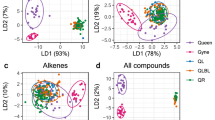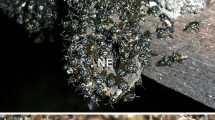Summary.
The dulotic queen ant, Polyergus rufescens, must first penetrate a host colony and kill the resident queen in order to successfully founding a new colony. Successful usurpation by a newly mated queen predictably depends on a dual strategy. Although, it can sneak in by being “chemically insignificant” with respect to cuticular hydrocarbons, it may also need to deter prospective host-worker aggressors. Chemical analysis of Dufour's gland secretion of P. rufescens queens and workers by GS/MS revealed that queen secretion is typified by esters of butanoic acid and acetic acid, of which decyl butanoate comprises over 80%. Butanoates and acetates are also present in the workers' secretion, but these are of higher molecular weight, and octadecyl butanoate represents the major compound. Using synthetic mixtures of queen and worker Dufour's gland, we tested the hypothesis that these secretions modify the aggressive behavior of the host species Formica cunicularia>. The queen-like synthetic mixture significantly reduced aggression of the host workers towards alien conspecifics, but neither pentane nor the worker-like synthetic mixture showed this effect. Although Dufour's gland content of >Polyergus queens was suggested to function as an appeasement pheromone (Topoff et al. 1988; Mori et al. 2000), we hypothesized that it may in fact act as a repellent. In order to test this hypothesis we exposed starved F. cunicularia workers to a droplet of honey on a glass slide applied with one of the following compounds: decyl butanoate (queen major compound), octadecyl butanoate (worker main compound), limonene (a reported ant repellent), and pentane (solvent control). Of these, the workers were repelled only by the decyl butanoate and did not approach the honey. We conclude that during usurpation the queen actively repels aggressive workers by emitting Dufour's gland repellent, comprising the alternative tactic in the usurpation dual strategy. This represents another chemical weapon in the diverse arsenal used by parasites to overcome the host's resistance.
Similar content being viewed by others
Author information
Authors and Affiliations
Additional information
Received 7 April 2000; accepted 17 May 2000
Rights and permissions
About this article
Cite this article
D'Ettorre, P., Errard, C., Ibarra, F. et al. Sneak in or repel your enemy: Dufour's gland repellent as a strategy for successful usurpation in the slave-maker Polyergus rufescens. Chemoecology 10, 135–142 (2000). https://doi.org/10.1007/PL00001815
Issue Date:
DOI: https://doi.org/10.1007/PL00001815




